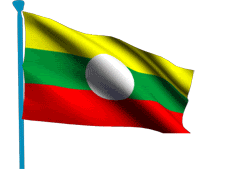Hualampong: Bangkok Railway Station
 Hualampong
HualampongLocated on Rama IV Road, Rongmuang, the Bangkok Railway Station is easy to find; nowadays there is a Metro station right at its door, Bangkok's Chinatown is across the highway. The Hualampong Station was built between 1910 and 1916, and modernized in 1998; its huge hangar features short towers at its corners and is one of the best known landmarks in Bangkok.
The station provides 24-hour service, including a post office, money exchange services, a Thai food plaza, bookstores in Thai and English, information booths, luggage deposit, hotel reservations and fast food joints, including a Dunkin's Donuts branch.
Its central hall is mainly used as a waiting area, but at its backside are twenty-four ticket windows, including some reserved for foreigners, which issue computerized tickets; unlike in China, the staff speaks reasonable English.
Trains
The services are divided into regular trains, rapid trains, express trains, and the Sprinter or special express train; these offer 3rd class, 2nd class sleeping, 2nd class and 1st class sleeping cars with or without air-conditioning. The trains are rather old; traveling across Thailand by bus is faster.
Planning a trip is easy, since the trains keep the same daily schedule; detailed timetables are available at the counters; reservations for the 1st class cars are not necessary.
Sturdy locomotives and dwarf, boxy cars define the Thai Railways; they impart a solid sense of safety and silently imply a capability to survive any accident.
Security and Pricing
It is highly recommended to travel first class, since there are recurring reports - and most Thais would warn about that - of thefts in the lower class cars; if traveling in the lower class cars, care should be taken with the luggage and no food should be accepted from strangers.
The price of first class tickets is considerably higher than a parallel trip on bus; while third class tickets are much cheaper than the similar bus tickets.
Lines
The Northern Line connects Bangkok and Chiang Mai, through Ayutthaya and Phitsanulok. The first special express train leave daily from 8:30 AM to 7:35 PM; the trip lasts twelve hours. In the opposite direction, there is one morning train at 8:45 AM and thee in the evening, at 4:30 PM, 5:50 PM and 9 PM; slower trains are available at other times. As of August 2009, a first class ticket costs 1,353 baht to Chiang Mai.
The Northeastern Line reaches Nong Khai, through Nakhon Ratchasima, Ubon Ratchathani, Khon Kaen and Udon Thani. There is a single special express train leaving Bangkok daily at 5:45 AM, but it reaches only Ubon; in the opposite direction special express trains leave from Ubon (2:50 PM, 7:05 PM from Si Saket); slower trains reach Nong Khai. The best option from Bangkok is the express diesel railcar, leaving at 6:30 PM and reaching Nong Khai at 5:05 AM; other express trains leave Bangkok between 8:20 AM and 9:50 PM (6 trains). A full trip from Bangkok to Nong Khai in first class costs 1,217 baht and longs ten hours.
Aranyaprathet - the northern border cross with Cambodia, leading to Angkor - is the final destination of the Eastern Line; though there is a side line reaching Chon Buri and Pattaya. This train has only third class cars, a trip to Aranyaprathet costs 48 baht ($1.5!!!).
Malaysia can be reached down to Butterworth with the Southern Line, which reaches also Hua Hin, Chumpon, Surat Thani, Nakhon Si Thammarat, Hat Yai and Yala. Five special express trains leave Bangkok daily between 8:05 AM and 10:50 PM. A first class ticket to Hat Yai costs 1494 baht. The whole trip to Malaysia longs twenty-one hours, while to Hat Yai just about fifteen.



No comments:
Post a Comment